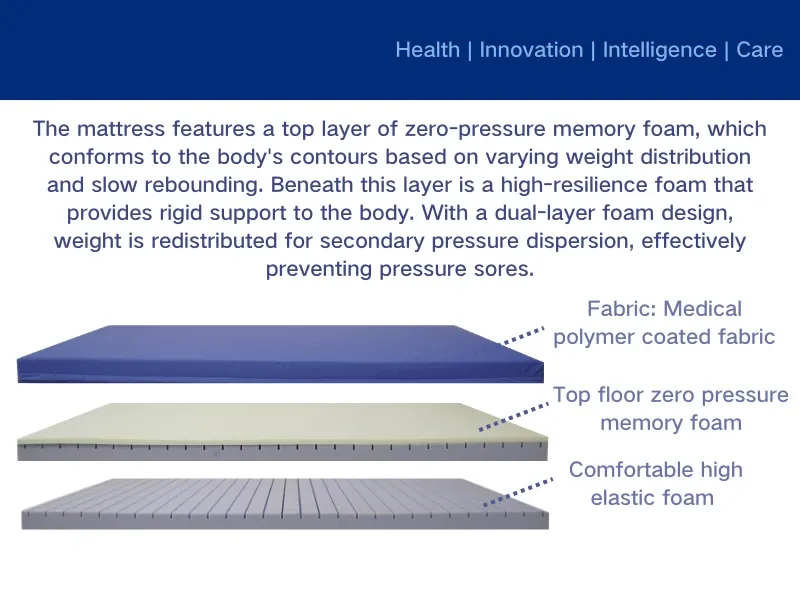The Critical Role of Pressure Relieving Mattresses in Preventing Pressure Ulcers
The pressure relief mattress represents a cornerstone innovation in preventive care for patients at risk of developing pressure injuries. These specialized support surfaces, also known as pressure relieving mattresses, are engineered to redistribute body weight and minimize tissue deformation over bony prominences where pressure ulcers typically form. Unlike conventional mattresses that maintain consistent firmness, a mattress to relieve pressure points dynamically adjusts support characteristics to reduce interface pressure below the capillary closing threshold of approximately 32 mmHg.

This sophisticated pressure redistribution capability makes pressure relieving mattress for pressure ulcers an essential component in clinical settings ranging from intensive care units to long-term nursing facilities. The evolution of these therapeutic surfaces reflects decades of research into tissue mechanics, microclimate management, and patient mobility considerations—all converging to create what modern medicine recognizes as a Pressure Ulcer Prevention Mattress system.
Biomechanical Principles Behind Pressure Redistribution of Pressure Relief Mattress
The effectiveness of a pressure relief mattress stems from its ability to manipulate the fundamental physics of tissue loading. When a patient remains stationary on a conventional surface, concentrated forces over bony areas like the sacrum, heels, and trochanters compress blood vessels and lymphatic channels. This compression creates ischemic conditions where oxygen and nutrient delivery becomes insufficient to maintain cellular integrity. A properly designed pressure relieving mattress interrupts this pathological process through several simultaneous mechanisms. The surface material properties are engineered to allow deeper immersion of bony prominences, thereby increasing the contact area and distributing forces over a wider tissue plane. This principle of "envelopment" distinguishes therapeutic mattress to relieve pressure points from standard bedding.
Advanced pressure relieving mattress for pressure ulcers incorporates viscoelastic memory foam or alternating air cell technologies that respond differently to various body regions. These materials exhibit time-dependent deformation characteristics that gradually reduce peak pressures as the material conforms to the patient's anatomy. The hysteresis properties of premium foams used in Pressure Ulcer Prevention Mattress systems ensure that the slow recovery phase maintains low interface pressures even during prolonged immobility periods. Furthermore, many advanced systems actively monitor and adjust support characteristics based on real-time pressure mapping, representing a significant evolution from static pressure redistribution to dynamic therapeutic intervention.
Clinical Efficacy in Pressure Ulcer Prevention of Pressure Relief Mattress
Numerous clinical studies have demonstrated the preventive benefits of pressure relief mattress systems across diverse patient populations. High-risk groups such as spinal cord injury patients, elderly individuals with limited mobility, and critical care patients all show significantly reduced pressure ulcer incidence when placed on appropriate pressure relieving mattresses. The protective mechanism operates on multiple physiological levels—maintaining tissue perfusion, reducing shear forces during patient repositioning, and managing the microclimate to prevent moisture-associated skin breakdown.
The superiority of specialized mattress to relieve pressure points becomes particularly evident when examining sacral pressure distribution patterns. Research utilizing pressure mapping technology reveals that high-quality therapeutic surfaces can reduce peak sacral pressures by 40-60% compared to standard hospital mattresses. This substantial reduction maintains tissue perfusion above critical thresholds even during extended bed rest periods. For patients with existing category I pressure ulcers (non-blanchable erythema), timely intervention with a pressure relieving mattress for pressure ulcers often prevents progression to more severe tissue damage by restoring compromised microcirculation.
Long-term care facilities implementing Pressure Ulcer Prevention Mattress programs report not only reduced ulcer incidence but also improved healing rates for existing wounds. The continuous pressure redistribution provided by these systems creates an optimal environment for tissue repair by eliminating recurrent ischemic insults that delay healing. Moreover, the reduced need for frequent manual repositioning decreases caregiver strain while maintaining superior protection—a crucial advantage in resource-constrained clinical environments.
-
Sleep Tracking Mattress Maintenance TipsȘtiriJul.22,2025
-
Mattress Wave Designs for People with ArthritisȘtiriJul.22,2025
-
Mattress for Back Pain and Spinal AlignmentȘtiriJul.22,2025
-
Hypoallergenic Properties of Silicone Gel MattressȘtiriJul.22,2025
-
How a Gel Memory Foam Mattress Regulates TemperatureȘtiriJul.22,2025
-
Doctors’ Recommendations on Special Mattress for Back PainȘtiriJul.22,2025
-
Customizing a Patient Bed Mattress for Specific NeedsȘtiriJul.22,2025

